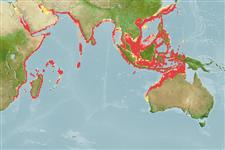Common names from other countries
>
Eupercaria/misc (Various families in series Eupercaria) >
Nemipteridae (Threadfin breams, Whiptail breams)
Etymology: Parascolopsis: Greek, para in the side of + Greek, skolos = stake + Greek, ops = appearance (Ref. 45335).
More on authors: Jordan & Richardson.
Issue
Distribution of this species is being updated. Use Stocks definition as guide for species range.
Environment: milieu / climate zone / depth range / distribution range
Ecologie
marien demersaal; standvastig; diepte 25 - 264 m (Ref. 9820). Tropical; 30°N - 28°S, 31°E - 136°E (Ref. 3810)
Western Pacific: southern Japan, Taiwan, the Philippines and Indonesia (northern Sulawesi),
Grootte / Gewicht / Leeftijd
Maturity: Lm ? range ? - ? cm
Max length : 35.0 cm TL mannelijk / geslacht onbekend; (Ref. 5450); common length : 35.0 cm TL mannelijk / geslacht onbekend; (Ref. 5450)
Dorsale stekels (totaal) : 10; Dorsale zachte stralen (totaal) : 9; Anale stekels: 3; Anale zachte stralen: 7. Head scales reaching forward to between middle of eyes. Posterior margin of preopercle more or less vertical, or sloping forward slightly. Lower limb of preopercle naked. Posterior margin of suborbital serrate, a small spine at upper corner. Pectoral fins long, reaching to or almost to level of anus. Pelvic fins long, reaching to level of anus. Color: Body pinkish. An elongate blotch at origin of lateral line. Upper axis of pectoral fin black. Pectoral and caudal fin yellowish.
Benthic on sand or mud bottoms in offshore waters (Ref. 30573, 48635). Feeds mainly on benthic invertebrates. Minimum depth reported taken from Ref. 30573.
Levenscyclus en paargedrag
Maturities | Voortplanting | Spawnings | Egg(s) | Fecundities | Larven
Miyamoto, K., C.D. McMahan and A. Kaneko, 2020. Parascolopsis akatamae, a new species of dwarf monocle bream (Perciformes: Nemipteridae) from the Indo-West Pacific, with redescription of closely related species P. eriomma. Zootaxa 4881(1):91-103. (Ref. 123359)
Status op de Rode Lijst van het IUCN (Ref. 130435)
CITES (Ref. 128078)
Not Evaluated
Gevaar voor de mens
Harmless
Gebruik door de mens
Visserij: visserij voor eigen gebruik
Tools
Speciale rapporten
Download XML
Internetbronnen
Estimates based on models
Preferred temperature (Ref.
115969): 19.8 - 28.1, mean 24.9 (based on 677 cells).
Fylogenetische diversiteitsindex (Ref.
82804): PD
50 = 0.5002 [Uniqueness, from 0.5 = low to 2.0 = high].
Bayesian length-weight: a=0.02089 (0.01189 - 0.03673), b=2.99 (2.84 - 3.14), in cm Total Length, based on LWR estimates for this species & (Sub)family-body (Ref.
93245).
Trofisch niveau (Ref.
69278): 4.2 ±0.29 se; based on food items.
Weerstandsvermogen (Ref.
120179): Gemiddeld, minimale populatieverdubbelingstijd 1,4-4,4 jaar (Preliminary K or Fecundity.).
Fishing Vulnerability (Ref.
59153): Low vulnerability (25 of 100).
